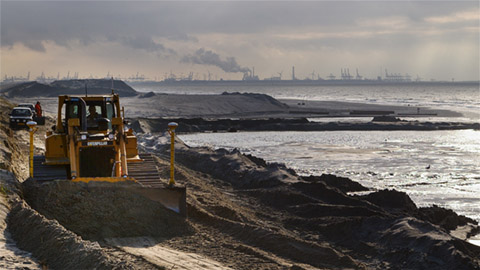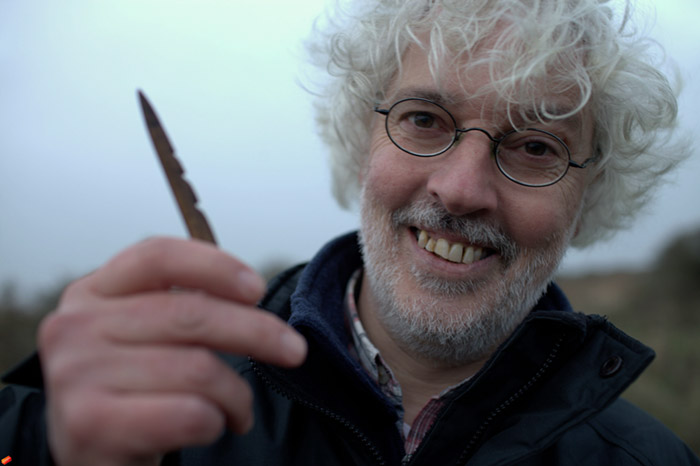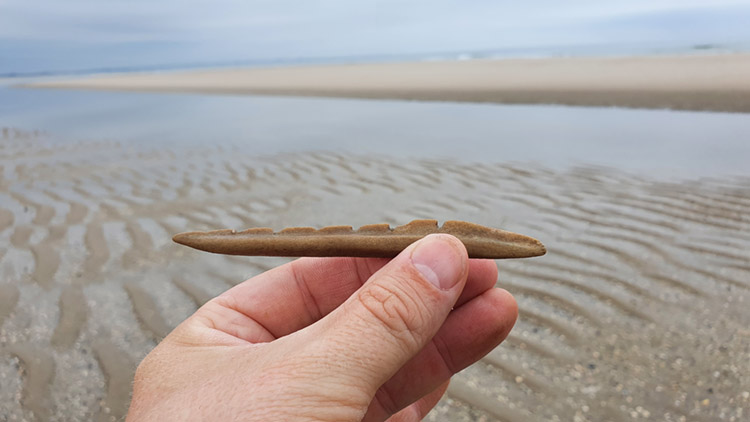
How did prehistoric people deal with climate change?
Atlantis in the North Sea
The gradual disappearance of Doggerland.
Animation Keith Hall (CC BY 2.0)
If you happen to take a stroll along the Zandmotor, the artificial beach near Kijkduin, this summer, you might just find more than shells and rocks, like arrowheads, or fish hooks. Perhaps you’ll find a piece of bone. You could even stumble upon a piece of a woolly rhino jaw, straight from the last ice age, like someone did last year.
Some of these artefacts wash up on shore, but they’re more often found in the 21.5 million cubic metres of sand that was used to create the area in 2011 in order to protect the Netherlands from the rising sea levels. This sand was taken from the bottom of the North Sea, from an area that once was an icy steppe where woolly rhinos roamed, rather than the grey sea we know today.
When the temperature started rising after the last ice age, the area turned into a forest where hunters and gatherers preyed on deer, aurochs, and wild boar. They worshipped nature and tried to survive in a land that sank a little more with each melting glacier.
Huge area
‘You have to understand: back then, you could just walk to England’, says archaeologist Merel Spithoven. ‘It was a huge area that stretched from the entire southern part of the North Sea, from England to Denmark.’
This area, which British geologist Clement Reid suspected existed as far back as 1913, when he wrote about a land bridge that would have connected England to the mainland, was inhabited until the end of the Mesolithic, and people often travelled through it. These days, it’s known as Doggerland. ‘We’ve found thousands of artefacts so far’, says Spithoven.
The plants and animals changed, and human beings had to adapt
She is one of the researchers who will be studying the artefacts over the next few years in an effort to get a picture of the daily life of the people they belonged to. The project, headed up by archaeologist Hans Peeters with the Groningen Institute for Archaeology, was recently granted 675,000 euros by research financier NWO.
‘We also want to find out how the rising sea levels impacted the socio-cultural development in the hunter-gatherer societies’, says Peeters.
Changes
When the glaciers started melting after the last ice age ended approximately fifteen thousand years ago, Doggerland slowly started to flood. Its inhabitants had to learn how to cope with the incredible changes to the landscape. ‘The area’s plant and animal population changed’, Peeters explained. ‘Human technology had to adapt to these changes.’
It’s also possible that people started behaving differently, changing their habits and traditions. That makes sense since this society was probably quite animist. ‘That means the people thought that everything, including plants and animals, had a soul’, Peeters explains.

There are plenty of clues that this was indeed the case. Spithoven, who focuses on studying arrowheads, discovered that a lot more small arrowheads were made during the Mesolithic. ‘We want to know if that’s connected to the changing landscape.’
It’s possible that people started hunting for fish more, which means they wouldn’t need as many heavy spears. Another option is that they switched to using a bow and arrow: this weapon is more accurate and better suited to hunting in forests.
Signs of use
The signs of use on the arrowheads hold a wealth of information. Deep vertical grooves indicate that the tip was sharpened using sandstone. If an arrowhead has a lot of these grooves, it wasn’t used much. It was possibly discarded or lost. Shiny, smooth patches on the tip means an arrowhead was often used to hunt deer. ‘It’s like those gold bits on bronze statues’, Spithoven explains. ‘The shine is because that particular spot was touched a lot.’
Perhaps some arrowheads were worn as a talisman
The researchers compare their arrowheads to those of more recent hunter-gatherer communities. ‘Research done in Papua New Guinea showed that they have a different word for each kind of arrowhead and that they all have distinct uses’, says Peeters. ‘Arrowheads that were used for hunting were never used in warfare.’
‘Some were perhaps never used. It’s possible the tips made by really good hunters were worn as a talisman’, Spithoven adds. ‘Like a good luck charm. We want to look into that, as well.’ It’s likely that arrowheads that went unused had some other function.
Isotopes
Arrowheads alone aren’t enough to shed light on Doggerland, however. Peeters put together a large, interdisciplinary team, with each member tasked with solving a different piece of the puzzle.
Michael Dee, with the Centre for Isotope Research in Groningen, will focus on carbon-dating the objects. Lisette Kootker from the Vrije Universiteit Amsterdam (VU) will figure out who ate what. She’ll do this by studying the isotopes found in human bone. Some of these atoms have a specific, deviating weight and they could only have ended up in the bone through the food the person it belonged to ate, like venison. The deer, in turn, would eat grass, among other things, which got its nutrients from the soil and the air. Each of these nutrients is labelled, so to speak, with isotopes that the body absorbs. This means a deer bone can tell you what the deer ate, and a human bone can tell you what that person ate.
These people had to learn how to deal with climate change
Then there’s another, somewhat creepy, mystery that needs solving. Earlier research that Spithoven was involved in showed that serrated bone arrowheads were made not just from animal bone, but also from human bone.
That is exceptional. ‘Why were they using human bone? Was it more readily available?’ Spithoven wonders. It’s possible these hunters and gatherers didn’t have the same scruples we do about using human bone. ‘You have to keep in mind that these people may have had completely different philosophies than we do.’
Apt
The Natural History Museum in Rotterdam will investigate the landscape, together with people from the VU and the UG. The project also includes geologists from Utrecht and research groups from Great Britain and Belgium that specialise in rising sea levels. They’ll combine DNA research with physical anthropological research that should shine a light on the genetic relationships of this group of hunter-gatherers.
Peeters and Spithoven can’t wait. The story of what happened to the Atlantis of the North Sea couldn’t be more apt. ‘The Doggerland communities can teach us how people dealt with big changes in their environment, changes to something so familiar to them’, says Peeters. ‘That links up with how we’re responding to our current situation.’
Spithoven nods: ‘These people had to learn how to deal with climate change, which is exactly what we’re doing right now.’
